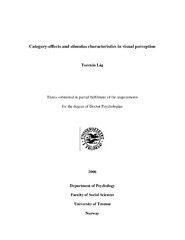Category-effects and stimulus characteristics in visual perception
Permanent link
https://hdl.handle.net/10037/354View/
Thesis introduction (1-50) (PDF)
This is a post-print (final draft post-refereeing) of Laeng, B., Låg, T., & Brennen, T. (2005). Reduced Stroop interference for opponent colors may be due to input factors: Evidence from individual differences and a neural network simulation, Journal of Experimental Psychology: Human Perception and Performance, 31, 438-452. http://www.apa.org/journals/xhp/ © 2005 American Psychological Association. Reprinted by permission. This article may not exactly replicate the final version published in the APA journal. It is not the copy of record. (PDF)
Låg, T, & Laeng, B. (submitted). Eye-position during identification of living and nonliving objects seen in canonical and non-canonical views. (PDF)
Låg, T., Hveem, K, Ruud, K.P.E., & Laeng, B. (2006). The visual basis of category effects in object identification: Evidence from the visual hemifield paradigm. Brain and Cognition, 60, 1-10. http://www.elsevier.com/wps/find/journaldescription.cws_home/622798/description © Elsevier 2006. Reprinted by permission. (PDF)
Låg, T. (2005). Category-specific effects in object identification: What is 'normal'?, Cortex, 41, 833-841. http://www.cortex-online.org/ © Copyright Masson S.p.A. 2005. Reprinted by permission. (PDF)
Date
2006-12-01Type
Doctoral thesisDoktorgradsavhandling
Author
Låg, TorsteinAbstract
This thesis describes a number of experiments that aimed to investigate
the role of relatively low-level visual input factors in category-specific effects in
object identification and colour perception. In the object recognition
experiments, using picture-name or name-picture verification tasks, as well as
object-naming tasks, clues to the causal factors contributing to such effects were
obtained. It was found that category-specific effects in normal object
identification, both living things advantages and living things disadvantages can
occur even when nuisance variables like familiarity and complexity are well
controlled. Task demands on perceptual differentiation and stimulus
presentation conditions can influence and even reverse category-specific effects
(Report I). When identification has to rely mostly on global shape visual
information, the living things advantage in identification is enhanced compared
to when visual detail is available in stimulus pictures. Furthermore, a lack of
visual detail induces a left hemisphere disadvantage for identification, but only
for nonliving things (Report II). In an experiment utilising eye movement
methods, it was found that when rotating objects in depth, which presumably
causes changes in outline shape, changes in participants' eye movement
strategies could be observed. Specifically, participants tended to focus more on
the objects' centres of gravity when rotations went from canonical to noncanonical
views. This effect was, however, only reliably observed for nonliving
things. (Report III). In a study examining differential interference effects in
Stroop performance, it was found that the amount of interference is smaller for
non-opponent compared to opponent colours. An artificial neural network that
coarsely implements a trichromatic input coding scheme can simulate this
reduced opponent colour interference. Additionally, it was found that individual
differences in colour discrimination ability are associated with individual
differences in Stroop performance. (Report IV).
Publisher
Universitetet i TromsøUniversity of Tromsø
Metadata
Show full item recordCollections
Copyright 2006 The Author(s)
The following license file are associated with this item:


 English
English norsk
norsk